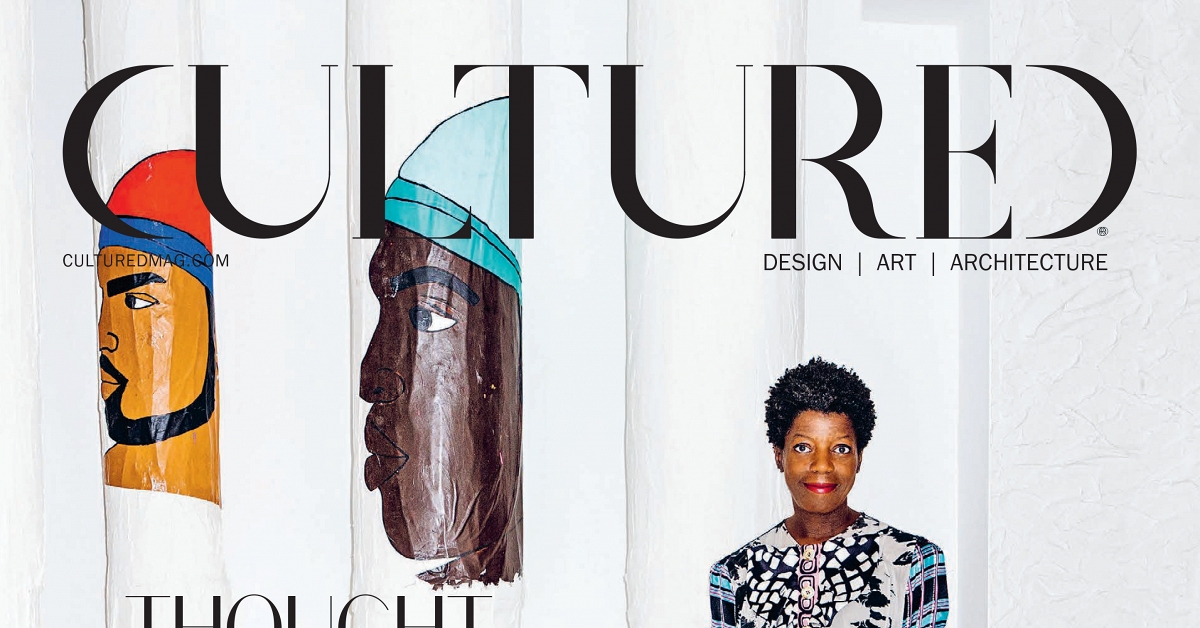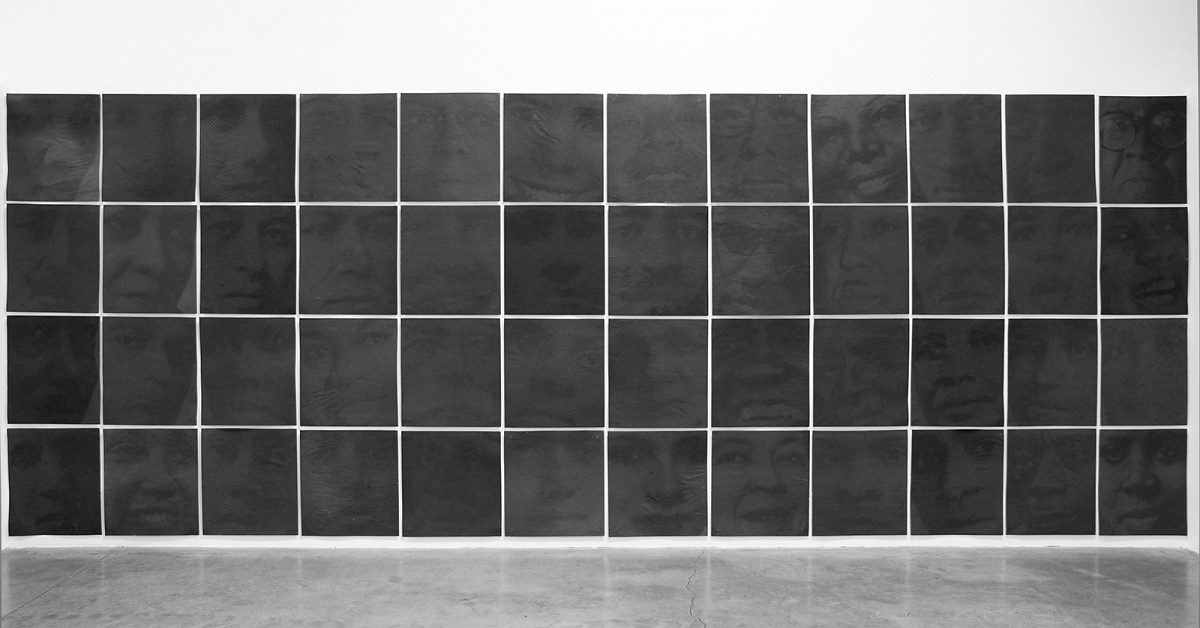Windows on the World
SF Weekly / Mar 8, 2017 / by Jonathon Curiel / Go to Original

Like Persian carpets from hell, Sanaz Mazinani’s art lures in visitors with its beautiful outlines of proto-Islamic geometries and the promise of calm and reflection.
But that promise dissipates ‚Äî badly ‚Äî when art-goers get much closer, as with Mazinani‚Äôs work called Trump on TV, which incorporates images she found on the internet. Mazinani patterns and re-patterns these images, including one from the stage of the final 2016 presidential debate, when Donald Trump groused about Hillary Clinton (‚Äúsuch a nasty woman”), and Muslims and immigration (‚ÄúWe are going to stop radical Islamic terrorism in this country”), and issued a phalanx of statements that were inaccurate.
Trump lied. And then repeated the lies. Mazinani’s repetition of Trump’s visage becomes a visual parallel to his insidious political crooning, and the way a repeated idea and a single image can gain traction.
‚ÄúI want to bring attention to how we consume media,” says Mazinani, whose new works are at SF Camerawork in an exhibit called ‚ÄúSanaz Mazinani: Signal to Noise.” ‚ÄúI wanted to use a singular image to talk about how we have so many screens, and so many TVs, and ongoing images surrounding us ‚Äî whether it‚Äôs on mobile devices or news feeds or Instagram or Facebook ‚Äî and how when we see one image repeated over and over, that might affect our understanding of the subject, whether it‚Äôs limited or pushes that to the forefront and replaces alternative versions [of the subject].
‚ÄúDonald Trump used media as a platform to push not only his voice and his image forward into the consciousness of the American public,” she adds, ‚Äúbut now he‚Äôs using his hate speech and divisionary plans and using the media to make it normative.”
Born in Iran and living in San Francisco, Mazinani surveyed the internet for nearly all the baseline images in ‚ÄúSignal to Noise,” whose title alludes to the convoluted power of imagery to shape public opinion about the world, including her native country.
Under Trump’s White House, the United States has already threatened to go to war with Iran, and one of Mazinani’s most provocative pieces at SF Camerawork is Shadow Wars, a wall-sized, magenta-and-blue work patterned with missile-carrying Predator drones and the silhouette of a soldier viewing a desert horizon. Mazinani, who will speak at SF Camerawork on March 9, from 6 to 8 p.m., in a conversation with Asian Art Museum educator Marc Mayer, tells SF Weekly that her dissection of media images and conflict “has become a more significant part of my practice. I’m talking about difficult subjects, but at the same time I believe in making art that can resonate and that people can enjoy. For me, it’s the yin and yang of it.
‚ÄúI want there to be a silver lining to it,” she adds. ‚ÄúSo the beauty and the harmony of these patterns provide an alternative perspective and an alternative way of thinking about a culture that most people don‚Äôt know too much about. In Iranian culture, in Islamic ornamentation, normally those patterns are on mosques or carpets. It‚Äôs a way to allow your mind to meditate and settle on an alternative to what‚Äôs happening in the world. It‚Äôs the physical versus the celestial. What I did was use the patternizations to talk about today, and the potential of a harmonious future.”
Mazinani is also featured in ‚ÄúMashrabiya: The Art of Looking Back,” at San Francisco State‚Äôs Fine Arts Gallery, which invited six California artists with roots in the Middle East to use the idea of the mashrabiya as a jumping-off point. A Middle East architectural feature that dates from the Middle Ages, mashrabiyas are stylized window screens, often with intricate latticework, that give people inside privacy and the discretionary ability to look outside. They‚Äôre a kind of architectural veil that masks both sides ‚Äî private and public.
In her ‚ÄúGeometries” series, Los Angeles-based Samira Yamin veils the media‚Äôs reporting on war, taking pages from TIME and meticulously cutting Islamic geometrical patterns into the magazine‚Äôs photos and text about soldiers, battle, and death. In 2013, for example, she took the Oct. 1, 2001 edition of TIME ‚Äî with Osama bin Laden on the cover (‚ÄúTarget: Bin Laden”) ‚Äî and denuded its power to inform. Yamin, whose parents emigrated from Iran in 1982, both prettified and obscured the issue, including its red-framed cover and its sprawling inside pages. ‚ÄúMashrabiya” features this geometricized magazine encased by a mirror that accentuates the thousands and thousands of openings ‚Äî stars, hexagons, and other ornate shapes ‚Äî that turn an international issue devoted to ‚ÄúWar & Terrorism” into a sea of unending ornamentation.
Yamin, who will often spend four 20-hour days working on a single page, says the mainstream media filters the Middle East almost solely through the lens of Islam, which badly distorts the way people understand the region. Her TIME revisions, she tells SF Weekly, are a commentary on this over-utilization — as well as on two themes that she says are a subtext of the media’s and the U.S. government’s Middle East strategies: creating fear and creating pity.
‚ÄúIslam as a way to talk about the Middle East obscures our view of the Middle East, which is a term that‚Äôs a political construction,” Yamin says in a phone interview from Los Angeles. ‚ÄúThe way images work, especially in a magazine, is that they‚Äôre consumed at a very particular pace, and we‚Äôre supposed to glean something relatively quickly from looking at an image. Fear and pity are the two common threads that we use to talk about the Middle East and North Africa. If you look at the language of going to war in Afghanistan in 2001, for example, it was that we need to protect ourselves from terrorists, and we need to liberate the women from the Taliban. One thing I‚Äôm trying to do is strip the content that perpetuates this language, so we can get to the structure of representation ‚Äî to say, ‚ÄòHow was this story actually constructed?‚Äô ‚Ķ That knowledge can be imposed back on the image to say that the image itself is a construction.”
In Taraneh Hemami‚Äôs different works at ‚ÄúMashrabiya,” the people of Iran and its diaspora are both cut out and visible ‚Äî a spectrum that reflects the volatile pattern of migration and memory that Hemami has found in Northern California‚Äôs Iranian-American community. Like Mazinani, Hemami was born in Iran and lives in San Francisco. Her Hall of Reflections mirror assemblage incorporates photos that range from focused to blurry, while her related Absence work excises people in photos and replaces their outlines with other images. The result: A kind of exquisite, captivating dissonance.
‚ÄúMashrabiya” and ‚ÄúSignal to Noise” coincide with an SFMOMA exhibit, ‚ÄúWhere We Come From,” by Palestinian-American artist Emily Jacir, which is more timely than ever given Trump‚Äôs vow to reconfigure U.S. policy in Palestine and Israel. Jacir, who can travel freely in the Holy Land because of her American passport, made ‚ÄúWhere We Come From” from 2001 to 2003. Through tight checkpoints and official policies that Human Rights Watch have called ‚Äúsevere and discriminatory,” Israel imposes strict travel and entry restrictions on Palestinians, including those with generational ties to Israel and the West Bank and Gaza Strip. In ‚ÄúWhere We Come From,” Jacir asked Palestinians around the world, ‚ÄúIf I could do anything for you, anywhere in Palestine, what would it be?”
Jacir‚Äôs photos and text, in English and Arabic, tell the stories of what she did, and those stories are much more profound than, say, an Associated Press news update from the region. One man Jacir contacted ‚Äî a Palestinian-Egyptian who was born in the West Bank town of Nablus, where his parents are from ‚Äî asked Jacir to climb Mount Carmel in Haifa and ‚Äúlook at the Mediterranean from there.” Jacir did, and photographed what she saw.
Another Palestinian man ‚Äî a New Yorker whose dad was exiled from Jerusalem in 1948, after the founding of Israel ‚Äî asked Jacir to visit the family‚Äôs Jerusalem home. Jacir did, found Palestinian workers renovating the house for its Jewish owner, and took an image of the stone building. A Houston woman with a Lebanese passport ‚Äî whose parents are from Haifa but were compelled to leave in 1948 ‚Äî asked Jacir to ‚Äúgo to Haifa and play soccer with the first Palestinian boy you see on the street.” Jacir did. She met a Palestinian boy named Kamel. They played soccer in the street. SFMOMA has the photo ‚Äî a bittersweet image of Jacir, Kamel, and a black-and-white soccer ball on a sunny day in Haifa. ‚ÄúWhere We Come From” would be even more difficult to make today, given the even tighter restrictions that Israel has imposed on Palestinian travel, but the project‚Äôs re-emergence at SFMOMA, where it‚Äôs on display until April 2, is a sign of a cultural shift that the Palestinian-American cultural critic and scholar Edward Said would have championed.
In February 2003, as Jacir was finishing her project, Said ‚Äî author of the trilogy of books that includes Orientalism, Covering Islam, and The Question of Palestine ‚Äî told me in an interview that, ‚ÄúWhat I stand for is what a lot of people stand for. They are no longer interested in Band-Aids.” Said, who would die seven months later from cancer, was talking about his long-held critiques of American and Israeli foreign policies and media representation of Arab societies. One of the many through-lines of Said‚Äôs scholarship, which he originated more than 40 years ago, was his plea for Arabs and Muslims to report on their own state of affairs ‚Äî to be the prism through which Americans and Westerners considered the complex narratives of the greater Middle East. From an art perspective, that‚Äôs what‚Äôs on display in ‚ÄúMashrabiya,” ‚ÄúSignal to Noise,” and ‚ÄúWhere We Come From”: Artists with deep roots in the countries and concepts they‚Äôre addressing, hoping to distill those roots to people who may have only a cursory understanding of them.
For these artists, it‚Äôs a balancing act that is not guaranteed to work. They know that. Yamin says she was heavily influenced by Said‚Äôs scholarship. Jacir, whom SF Weekly tried to reach for comment, once said, ‚Äú ‚ÄòWhere We Come From‚Äô is a failure in some way. I am not sure how to reconcile the notion that non-Palestinians are being entertained by our sorrows and dreams.”
It‚Äôs debatable whether SFMOMA‚Äôs exhibit of ‚ÄúWhere We Come From” is merely ‚Äúentertainment.” But what‚Äôs not debatable is that Jacir‚Äôs work ‚Äî along with the work of Mazinani, Yamin and the other artists in ‚ÄúMashrabiya” ‚Äî presents a deep humanity and critique of the region that is important to see first-hand. Their work connects the greater Middle East to the United States ‚Äî and to the Bay Area ‚Äî at a time of extreme uncertainty when so many people are longing for a different reality.






